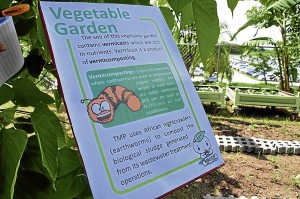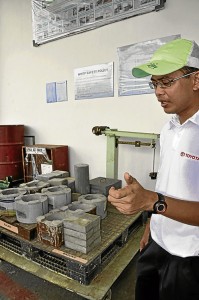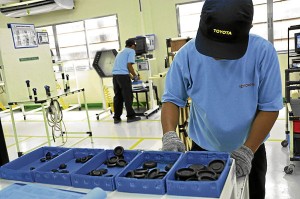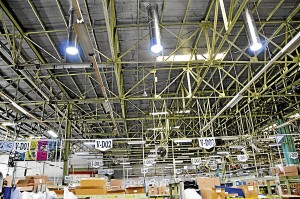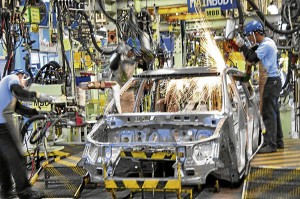Secrets of Toyota Eco Forest unearthed
STA. ROSA, Laguna—It’s the stuff that could scare little kids up their bedrooms. The story went around that a python crawled up an electric post, got in contact with the live wire, and was electrocuted.
The story turns out to be true, and more surprisingly, the incident happened inside the 82-hectare Toyota assembly plant in Sta. Rosa, Laguna just recently, and had interrupted power to the facilities.
That may have been a tragic and bizarre ending for the poor python (which, even after death, suffered the indignity of being the subject of numerous coffee-break banter among employees, who joked that the snake committed “hara-kiri”). For the people who run the Toyota plant, however, the fact that a runaway python could even have existed inside an industrial facility is testament to the success of the Toyota Eco Forest, and proof that nature and industry can coexist.
This point couldn’t have been belabored enough when members of the media were given a tour inside the Toyota Sta. Rosa plant and its 14-hectare Eco Forest. During the walk-through of the forest, the guests were even reminded to strictly follow the pathway so as not to disrupt whatever affairs the flora and fauna were into at the time. That’s how serious Toyota’s resident environment scientists regard their duties.
Admittedly, once you get to see for yourself how automobiles get assembled and all the chemical cocktails sprayed and sloshed around to quicken and toughen the process, you will realize how easy it is for the industry to lay waste to the environment. And Toyota’s own assembly facilities are no exception. Here, journalists saw how Vioses and Innovas were pressed, welded and painted to form.
Article continues after this advertisementWhat makes Toyota Sta. Rosa an exception is how it seamlessly puts together a world-class automobile assembly plant and a completely sustainable ecological system. The public may easily see the Eco Forest and the assembly lines, but what is not readily seen is Toyota’s dead seriousness in cleaning up the mess and pollutants of its industry.
Article continues after this advertisementEmployees harvest mangoes
Toyota revealed just that to the visitors as the hosts showed the 5,000-sqm water treatment facility which they claimed cost P70 million to build in 1996, as well as a man-made lagoon filled completely with the treated water. And to show the water was clean enough and met the regulatory standards of effluent water to sustain life, schools of tilapia were raised.
Engineer Danny Penaflor, Toyota Motor Philippines’ own horticulturist, also said that up to 92 plant species could be found in the Eco Forest, and they were grown in their own nurseries. The mango trees have also been bearing fruit, and every harvest season mangoes are distributed among the employees, a “bonus” from nature, it would seem.
Chemical engineer Mark Anthony G. Marcelo, supervisor and control pollution officer of the cost and environment section, describes the eco forest as a carbon sink that also provides sanctuary for birds and animals (and yes, pythons, too, which are, in fact, endemic to the area). Marcelo added that the forest also gives aesthetic value to the Toyota assembly plant and creates an impression of harmony with nature.
A Vios every 12.5 minutes; Innova every 16.7
However, for all the thoroughness of the TMP Sta. Rosa plant in maintaining the ecological balance of its premises, the most prolific kind of animal bred here are the metallic ones. Every 12.5 minutes, a Vios sedan sprints out of the line. Every 16.7 minutes, an Innova gallops out the gates, and into the dealerships and garages of happy owners. These metal beasts will join the pack of millions of other automobiles running on fossil fuels igniting in internal combustion engines—a process that has been determined to be the third leading cause of greenhouse gas production that has helped accelerate worldwide climate change.
The manufacturing sector itself, in which TMP as a car assembler/manufacturer belongs, is the seventh leading cause of greenhouse gases.
Acknowledging its adverse impacts on the environment and the climate, TMP had taken up efforts to mitigate these effects in any way it could. One of those ways is the installation of 49 solar tubes (that cost P30,000 each) and solar panels for its several facilities, as shown by Alden M. Sapit, vice president for production.
Marcelo explained that the biggest pollution impact in the carmaking process is in the water. On top of that, the assembly plant’s energy-consuming boilers and ovens can also contribute to air pollution if not properly maintained and controlled. And then the assembly line also generates solid waste, including those with hazardous and toxic components.
Marcelo is one of four engineers directly involved in the management of the environment systems of TMP Sta Rosa. They join 78 other engineers working in the Toyota manufacturing division, including the operations, maintenance and planning.
LPG to dry paint faster
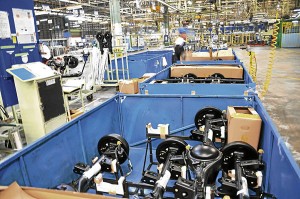
TOYOTA started implementing the SoC-free project here, which ensures that all parts and materials installed, attached, or applied on the vehicles do not contain substance of concern elements (hexavalent, chromium, mercury, cadmium, lead).
Car paints and paint process contribute the most number of pollutants in the plant, according to Marcelo. And among all the main production processes, painting has the highest energy consumption.
TMP uses LPG in its ovens to speed up the paint drying process. Compared with diesel and bunker fuels, liquefied petroleum gas has a lower emission level.
Water used in the paint shop’s dipping process for surface preparation and coating, as well as the overspray of paints, is collected in a sludge pool. This sludge pool, Marcelo demonstrated, contain high heavy metal content as well as oil and grease and chemical oxygen demand (COD).
“To ensure that these contaminants will not pollute the river system, all of the processed water at the painting shop must be treated at WWTP (waste water treatment plant) prior to its discharge,” he said.
Thinner and paints contain volatile organic compounds (VOC), which can be harmful to both health and environment. TMP’s first strategy is to reduce its consumption. For this end, precision robots are used to efficiently and consistently spray paint the vehicle units. Another process innovation was the three-wet paint system which reduced the paint and LPG consumption.
80% lower
In a day, the WWTP can accommodate 850 cubic meters of polluted water for treatment, more than enough capacity to treat TMP’s daily wastewater output of 400 cubic meter per day. To ensure that TMP meets the regulatory effluent standard, the plant administration department has set an internal standard of 80 percent lower than the regulatory limit. TMP’s actual discharge, according to Marcelo, is almost 50 percent less than the government standard.
The WWTP incorporates physical, chemical and biological treatment processes. The chemicals normally found in the water being used for industrial purposes by a car manufacturing facility such as Toyota warrant the need for the biological treatment of the water.
Marcelo explained that the water is treated biologically using chemical processes such as pH adjustment, coagulation and flocculation. Biological treatment is primarily used for the sanitary wastewater coming from toilets and kitchens. Bacteria are introduced to decompose organic pollutants. These treated organic pollutants and the dead bacteria become sludge and get separated with the treated water at the sedimentation tank.
TMP has also formed partnerships with the Department of Environment and Natural Resources (for air pollution and waste) and the Laguna Lake Development Authority (for water pollution). “Every year, we renew and revalidate our permits with them and submit quarterly performance reports. Once a year, they make a surprise visit to inspect/audit TMP,” Marcelo said.
The media was also brought to a laboratory near the WWTP. The laboratory houses equipment called energy dispersive x-ray fluorescence, or EDXRF, to measure the four priority elements in car components and materials that must be phased out in vehicles that are at the end of their useful lives, as recommended in the End-of-Life of Vehicles program originally from the European Union.
Another equipment in the lab, the atomic absorption spectrophotometer (AAS), measures heavy metals in water. This lab facility has been accredited by the DENR to conduct heavy metals analyses for water.
Tough tilapia
Marcelo showed tilapia alive and well in the treatment facility. He described the fish as a hardy species that can survive at conditions near the regulatory limits for water pollution. Marcelo said other fishes, such as carp, can also be found in the lagoon, and are also ideal indicators of the effectiveness of the WWTP.
The media was also brought to the sedimentation tank, the main purpose of which is to physically separate the treated water from the sludge using gravity. Surprisingly, tilapias are also released in the sedimentation tank, where they eat the algae and mosquito eggs or nymphs.
The mini-lagoon is where treated water from WWTP end up. Here, various fishes prove that the water being discharged is clean enough to sustain life.
Kangkong (swamp cabbage) grown in TMP Sta. Rosa’s constructed mini-wetland shows the effectiveness of natural treatment of wastewater through biofiltration. Numerous studies have shown that swamp cabbage is ideal for wastewater treatment. Although constructed wetlands require big land areas, TMP Santa Rosa’s mini-version shows its advantage in low operating cost, as it wouldn’t need any other chemicals and electricity.
Marcelo also revealed that the TMP Sta. Rosa makes use of microscopic fungi (trichiderma) to partially decompost fallen leaves and branches.
“Since we have lots of trees in our plant, we need to manage the huge volume of this type of waste. Instead of throwing (the leaves) into landfills, composting is the best waste management tool to address this waste,” Marcelo said.
Another technique Marcelo’s team uses is vermicomposting, which employs earthworms (African night crawlers). These earthworms compost mainly the biological sludge TMP generates at the WWTP operations.
Away with mercury
TMP Santa Rosa also demonstrated another machine, its “bulb eater,” which deals with the mercury in fluorescent lamps.
The bulb eater prevents busted fluorescent lamps from contaminating the air with its mercury vapor. Mercury is a heavy metal that has been known to cause different diseases in humans, such as minamata disease. Mercury, once it enters the body, cannot be excreted. It bioaccumulates inside the human body over the course of a lifetime.
TMP has also manufactured bricks made from excess cement, sand and crushed glass.
In the end, these ecological and environmental efforts of TMP Sta. Rosa may or may not necessarily improve employee productivity and product quality. As Marcelo said, “There has been no study conducted yet to measure that.” But then the Eco Forest isn’t merely for humans, after all. They’re just along for the ride.
